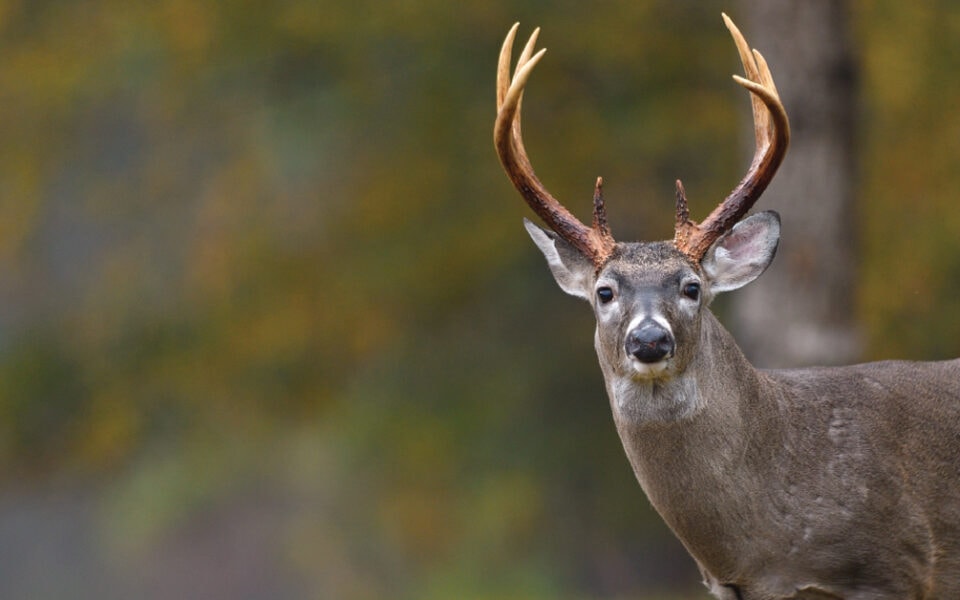I’d barely had time to ponder what just occurred when it happened. The wind was right. I wasn’t moving, why were these deer suddenly nailing me when all the others had ambled by undisturbed. I did eventually discover the answer, and it’s something every deer hunter should be aware of. But first, a few basics on understanding whitetail deer senses.
Whitetail Deer Eyesight
The eye is an incredible organ. It allows an individual animal to view, and in conjunction with the brain, perceive its surroundings. Because the eyes and brains of different species vary, each perceives its world differently. While we can never perceive things the same way as a deer, we can at least better understand how they might, by comparing their vision to ours, thanks in large part to ongoing research by Dr. Karl Miller and his team at the University of Georgia.
Deer and humans both have round eyes. Our pupil (the organ that dilates and constricts to alter the amount of light reaching the eye) is also round, but a deer’s is more oval, almost rectangular. This shape reduces light energy entering the eye from above and below while maximizing light from the horizon, where most danger lies.
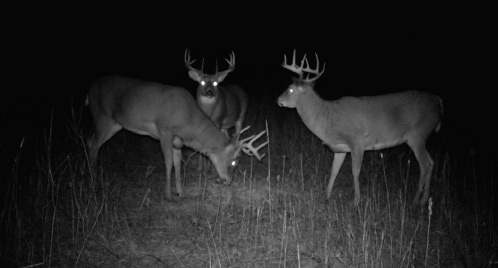 As a result, their visual acuity is also best along this horizontal plane (more on that in a bit). Conversely, their upper and lower peripheral vision is poorer than ours. It was once believed that deer don’t look up. Any experienced bowhunter will tell you “that’s not true.” They most certainly look up and it’s likely so they can focus on whatever object or movement caught their attention. If you sit still and quiet, not giving them cause to look up, they probably won’t, but they certainly can.
As a result, their visual acuity is also best along this horizontal plane (more on that in a bit). Conversely, their upper and lower peripheral vision is poorer than ours. It was once believed that deer don’t look up. Any experienced bowhunter will tell you “that’s not true.” They most certainly look up and it’s likely so they can focus on whatever object or movement caught their attention. If you sit still and quiet, not giving them cause to look up, they probably won’t, but they certainly can.
Deer also have larger eyes and as a result, bigger pupils. According to Miller, these larger openings increase light gathering ability to about nine times that of a human. But that’s only part of why they see better in low light.
Deer and humans have two types of light receptors in their eyes: rods and cones.
Rods are very sensitive to light, and help us see in low light, which we perceive largely as black and white. Rods are much bigger and bundled, three to each nerve ending. They’re not as good at picking up detail or movement, providing only a very coarse image. Having more rods than humans would, in and of itself, give deer a further advantage in night vision, but their advantage doesn’t end there either.
They also have a reflective layer on the retina called the “tapetum lucidum.” This is what causes the reflective eye-shine when illuminated. When light strikes the retina, some is absorbed by the rods and cones and processed by the brain. The rest strikes the tapetum and then gets bounced back over rods and cones, a second time. According to Miller, this gives deer about an 18 times greater ability to see at night than humans.
When it comes to color, deer don’t get all the advantages. Humans have a small pit of densely packed cones on the retina called the “fovea centralis.” This allows us to better focus on an individual point. Deer lack this fovea. We also have more cones than deer. And because each cone has its own nerve fiber we see more detail, in good light.
And, humans are trichromats, meaning our cones have three types of photo pigments that peak when exposed to different wavelengths of light corresponding to the colors blue, green and red. As every other color is some combination of the above, we have a much broader visible spectrum. We don’t see in the blue part of the spectrum quite as well because we have a yellow filter that blocks out UV (blue) light, which is not as helpful for visual acuity. Most of our vision therefore, is in the red and green part of the spectrum. All of the above are advantageous if you are a “daylight predator.”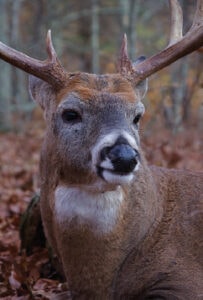
Through Miller’s research we’ve learned that deer are dichromats, having two photo pigments, one for blue and the other for about halfway between our red and green. According to Miller, “Light reflected in other parts of the spectrum, in the neutral zone, probably looks gray to them. Anything that’s dark red looks black do a deer, and they don’t see blaze orange as well as we do.” The latter is an important point, especially for the firearms hunter.
Of perhaps greater importance to both bow and gun hunters is where deer realize a real advantage. Miller’s team used a Deer Training Apparatus and an operant conditioning experiment to determine that deer actually see into the blue part of the spectrum 20 times better than humans, largely because they lack the yellow filter – but the story still doesn’t end there.
While our cones are concentrated in the fovea centralis, giving us better visual acuity, the deer’s blue cones are scattered across the retina. They also have about twice as many. Furthermore, our eyes are constantly moving because we’re looking at a point in space, like a predator would. Deer eyes don’t move as much because they’re already seeing a “bigger picture.”
This becomes most important at twilight, when deer are most active. Light gets diffused and there is about two to three times the ambient blue light compared to red and green. Visual acuity becomes less important but the ability to see blue, and in low light offers a dual asset. Add a large pupil, the tapetum and more rods and you have an animal that sees very, very well in low light.
Their “field of view” is also much different than ours. Because we are predators and deer are prey, their eyes are positioned on the sides of their head giving them a much wider field of view, 310 degrees compared to 180 degrees for us. The advantages here are obvious. It’s also helpful to know, especially if you’re a bowhunter. Taking advantage of their 50-degree blind spot also coincides with a quartering-away shot, which many bowhunters consider optimal.
Whitetail Deer Sense of Hearing
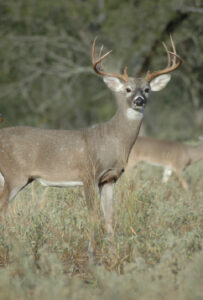
The whitetail’s sense of hearing is less important, at least in terms of communication, as evidenced by their limited vocabulary. They communicate far more through smell, and sight, the latter through body language and gestures. But they do use hearing as another means of detecting danger. It’s difficult to quantify the difference but their “radar dish like ears” clearly have more surface area for collecting sound waves and funneling them to sound-detecting organs. And unlike humans, they can move and orient their ears individually to scan and pinpoint sounds.
As with sight, ears work in concert with the brain to detect, then analyze sound. Think for a moment how you perceive sound in the woods. Over time, you gain the ability to recognize and differentiate specific sounds, like telling the difference between a squirrel hopping across the forest floor from a turkey scratching for acorns or a deer slowly walking. Now consider that deer live in those same woods, 24/7-365, and their ability to differentiate sounds must be far greater than ours. Try to minimize noise, especially unnatural sounds like the friction of artificial fabric, anything metallic or the steady bipedal gait of a human.
Whitetail Deer Sense of Smell
I saved the best for last. We don’t really know exactly how acute the whitetail’s sense of smell is because we have no way of measuring. We just know it’s really, really good. Some studies suggest it may be 10,000 times that of a human, based on the amount of surface inside their long, slender noses that is exposed to and designed for detecting odor and the dramatically expanded portion of the brain devoted to decoding odors. Even then, we’re just, if you’ll pardon the expression, scratching the surface.
Beneath that surface layer of odor detecting organs is a network of nerves far more complex than that of humans. Deer also have a vomeronasal organ in the roof of their mouth specifically designed for odor detection and probably identification. And who knows how much more complex their brain is at analyzing all the scent information it receives.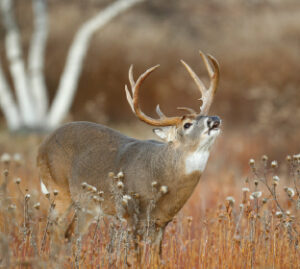
While it’s difficult if not impossible to prove, biologists believe that from a single whiff of urine, deer may be able to determine multiple things about the deer that deposited it, including sex, age, status and possibly even the individual’s identity.
The whitetail’s acute sense of smell is a strong defensive weapon but it can sometimes be used against them.
Odor Reduction
The first step is reducing our own human odor, and notice I say “reducing” rather than eliminating because the latter may be virtually impossible. Just as deer can quickly and easily recognize foreign or unnatural sounds, they can pick out foreign odors. And because they’re sense of smell is far greater than their hearing, they do a much better job at it. There are myriad of formulations and solutions on the market to reduce or mask human odor. It’s up to you, the consumer to decide what works best for you.
Just remember that like a chain, your scent reducing system is only as effective as its weakest link. Bathe and wash clothing in scent free soaps that remove dirt and oils. Spray all your equipment with odor-reducing solutions. Spray and/or wipe yourself and your equipment down upon reaching your stand. And store all of the above where they will not pick up foreign odors. In short, minimize your presence, just as you would by wearing camo clothing and sitting still and quiet.
Attraction
If the whitetail has one sometimes fatal flaw it’s curiosity. They are attracted to familiar and sometimes unfamiliar odors. The best and most obvious example of the former is the aroma of other deer, and this has spawned an entire industry of urine and glandular based attractants for hunters. Entire articles and even books have been written on the subject. Suffice to say they work.
The real curiosity is how foreign odors like anise and vanilla also sometimes work. Who knows why and it doesn’t really matter, so long as they achieve the desired result. Just bear in mind, they don’t always work, and they are not magic potions. You still have to apply scent control and a healthy dose of woodsmanship to be consistently successful.
Conclusion
The white-tailed deer really is a marvel of natural selection, with senses keenly adapted to avoiding danger. If you expect to defeat them you must first know what they are and just how well they work. Next, you can take steps to overcome them, by minimizing your presence in their environment. More often than not they still somehow pick us out. But if you’re meticulous and conscientious in how you go about it, you can increase the probability that things will work in your favor.

